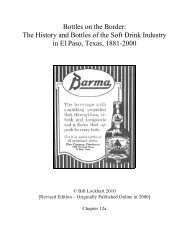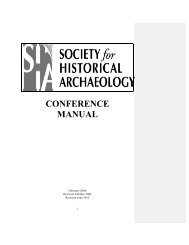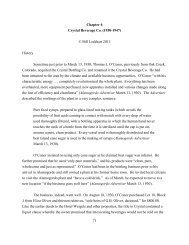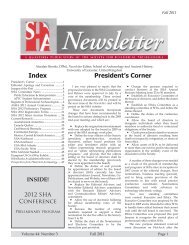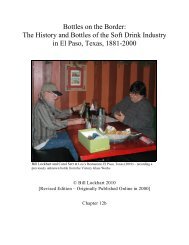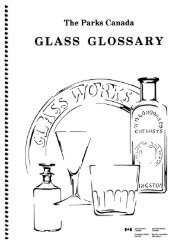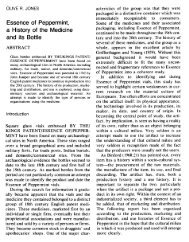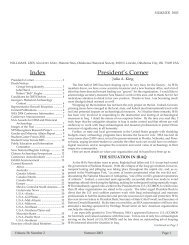1242 Codd Bottles revised
1242 Codd Bottles revised
1242 Codd Bottles revised
Create successful ePaper yourself
Turn your PDF publications into a flip-book with our unique Google optimized e-Paper software.
THE RISE and FALL of the HOPE<br />
GLASS WORKS by Mark POTTEN<br />
Even including the “Non-<strong>Codd</strong>ites” amongst us, I’m sure we have all heard of Ben and Dan RYLANDS<br />
from Stairfoot, Barnsley and their HOPE GLASS BOTTLE WORKS. Through time they established one<br />
of the biggest marble stoppered bottle factories in the UK with continuous success for over six decades.<br />
Presently this site is being demolished to make way for a new housing estate. Although only part of the<br />
original early 1890s factory and chimney stack remained, now is an apt time to pay homage and give a<br />
brief history of “The rise and fall of the Hope Glass Works”.<br />
Ben Rylands was born in Rothwell, just outside Leeds, on 16 th Jan 1825. He served a glass/bottle making apprenticeship with<br />
his uncle Mr.Winterbottom from Castleford and completed his apprenticeship under Messrs. Breffitt & Co., at the Aire & Calder<br />
Glass Works. In 1850 he became a partner in the Mexborough Flint Glass Works, this being the first bottle making company in<br />
the Mexboro area. In 1852 in a new partnership he started the Swinton Glass Works (South Yorkshire Glass Bottle Company).<br />
Photo 1.<br />
A view of<br />
the HOPE<br />
GLASS<br />
BOTTLE<br />
WORKS<br />
from the<br />
mid. 1890’s<br />
In 1867 Ben built his own works, namely the Hope Glass works, next to the Stairfoot Railway station in Ardsley near Barnsley.<br />
The site that he chose was ideal, with ample space for expansion, railways passing through it and the Dearne and Dove Canal<br />
alongside. It became sufficiently profitable for him to lease a second works in 1872, the Dearne & Dove Glass Works at Wombwell,<br />
a few miles away.<br />
Ben started working with Hiram <strong>Codd</strong> in September 1873, helping in the development of a tool to produce the groove in<br />
the lip of the bottle (which <strong>Codd</strong> & Foster then patented in December 1873). The problem with Brooke’s earlier tool was that<br />
the groove formed in the lip was never<br />
exactly the same size: this was dependent<br />
on the amount of molten glass added to<br />
the neck to form the lip and the amount<br />
of pressure applied to the tool, so there<br />
had to be numerous different size rings<br />
to fit each bottle made. <strong>Codd</strong> & Foster’s<br />
tool alleviated this problem by making all<br />
the grooves produced the same size. In<br />
December 1873 Ben manufactured 800<br />
gross (over 115,000) sample bottles to<br />
prove that the tool produced the same size<br />
groove in them all. He took out a licence<br />
to manufacture <strong>Codd</strong>’s bottles on 7th April<br />
1874 and was the first manufacturer to<br />
use the newly patented Groove tool in full<br />
Photo 2. An early Ben Rylands advert dating from late 1875<br />
production (see Photo 2).<br />
ABC - Issue 31 11






